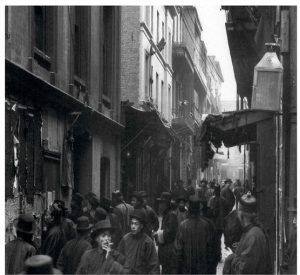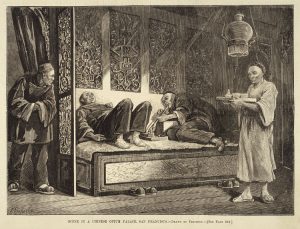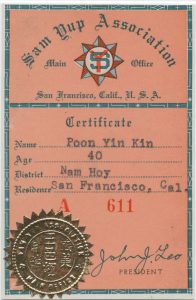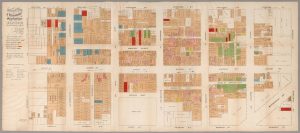The Original Chinatown

This photo shows the streets of San Francisco’s Chinatown. This street is specifically known as a “Gambler’s Alley.” There was a lot of gambling done in China towns across America, as most of the immigrants were men. There are no women to be seen in this picture which again shows the bachelor’s society that China towns were known for. This photo is taken from when Chinese immigrants first settled in America. The lives of the Chinese immigrants were initially very hard, the vast majority of the immigrants were men so most of them had families that were left behind in China. Some immigrants began new lives and started new families in America, while others continued to write home to their Chinese wives hoping to be reunited with them in the future.
This map of Chinatown in 1885 shows how fast Chinatown in San Francisco grew, as well as the culture that seemed hidden inside the Chinatown walls. This map shows a detailed outline of every building and its use in Chinatown. There is a color coordination which designates buildings which were used as opium dens or prostitution houses. Because of the heavy anti-Chinese sentiment just before the beginning of the 20th century, Chinese immigrants often had to seclude themselves in Chinatown to protect their own well-being. This meant that China towns in California and eventually across the United States developed very close communities which is still seen in today’s China towns.
Mining and Railroad Work

This image depicts Chinese immigrant workers beginning to work on the production of the railroads. The railroad industry began to boom in the late 1800s and as more and more wealth began to spread through America, the western frontier needed railroads. Chinese immigrants were known to work on the railroads in very tough conditions, they worked long hours and often did not get paid as much as the white American worker. From the picture above it is important to note that the workers seem to be in the beginning stages of building the railroad, but the railroad seems to be on a mountainous region of Northern California. Building railroads on terrain like mountains is extremely difficult and dangerous.

This illustration shows Chinese immigrant workers mining for gold. There are a few men in the back doing the actual mining while two other workers sift through dirt collected to find small particles of gold. The men all have similar appearance and are wearing traditional Chinese farming clothing. During the late 1800s, Chinese male immigrants almost all had the same hairstyle. This hairstyle is quite iconic in that the Qing Dynasty required all of the Han Chinese to wear this style of hair. This ponytail like style also created stereotypes which were used to depict Chinese immigrants in political cartoons. Over time Chinese immigrants developed their own style and many Chinese began to have more western hairstyles or their own individual hairstyle.
Everyday Life

This image above shows a Chinese New Year celebration in the streets of San Fancisco’s Chinatown in the 1920s. A man dressed up as a dragon dances around as the people of Chinatown watch closely. The change between the population of Chinatown in the late 1800s to the 1920s is quite substantial. In this photo, there are many women and most of the men are now dressed in more western style clothing than they were in 1880. This celebration shows the iconic dragon dance that is still widely practiced across China and China towns in the United States.

This illustrations shows Chinese men at an opium den in San Francisco. In history, Opium as a drug and the opium trade is often associated with the region of Canton and Hong Kong. Opium was a significant part of the lives of Chinese people and especially the people from the Canton region where the drug was widely used. This culture was brought over from Canton and opium dens were seen all over China towns in California. This shows that although the majority of Chinese immigrants struggled, the wealthy Chinese that were able to immigrate successfully to America were able to bring this wealth over the pacific with them.
Chinese American Association

A certificate of membership for a Chinese American Association in San Francisco. This shows how the immigrants came together and formed organizations which still exist today for Chinese Americans. It gives an idea of how Chinese culture was brought over and continued in America by the Chinese immigrants. What is very important to note is the names of the Chinese immigrants. In the certificate above, the Chinese man’s name is Poon Yin Kin, this is a Cantonese name. In fact, almost all of the Chinese immigrants that were arriving in America at the time were from the Canton region of China. Canton is where modern day Guangzhou is located, in the most southeast part of China. It is also interesting to note that most of the stereotypes that came from Americans hearing the Chinese language is actually from Cantonese. There is still an misconception today that Chinese still speak Cantonese even though Mandarin Chinese and Cantonese sound quite different when heard closely.

